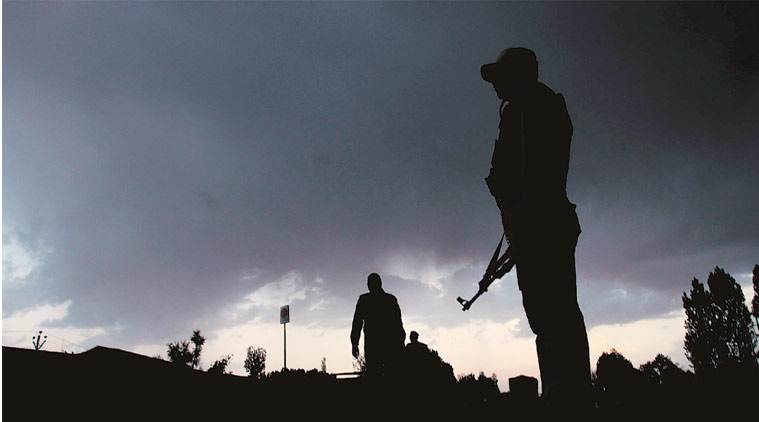
SOURCE: ENS
Tariq Mohand, a carpenter from village Heff in Shopian district, was abducted by terrorists on the evening of July 8, 2018. This village in South Kashmir has been home to a number of terrorists over the years. Tariq was the cousin of a terrorist named Bilal Mohand who was killed in an encounter in May 2018. The terrorists who abducted Tariq tortured him through the night. His body was recovered from a nearby village next morning.
Tariq was buried in a normal graveyard in his village. There was huge resentment in the village against this gruesome act and the terrorists were condemned unequivocally. Two days after killing him, the terrorists labelled Tariq as a “martyr”. His body was exhumed four days after the murder and buried in the “martyrs’ graveyard” of the village. His family, including his pregnant wife, had to undergo much trauma that week. Tariq’s unfortunate death and the pain suffered by his family point to the deep scars that terrorism leaves on people’s lives in the Valley.
Over the last 30 years, such tragedies have occurred at regular intervals in the Kashmir Valley. The most egregious of such excesses take place when civilians labelled as “informers” are murdered. Over the years, there has been an increased tendency to understand the impact of terrorism by referring to incidents that involve the killing of a considerable number of civilians or security personnel. In the same vein, the number of terrorists neutralised is seen as an indicator of success against terrorism. The most important aspect of this phenomenon, checking the recruitment of young boys to terrorist ranks, is often ignored. The process of recruitment is not a very complex one. The recruits to various terror organisations in the aftermath of the killing of Burhan Wani were mostly from South Kashmir.
A cursory look at the data can help put the process in perspective. The number of new recruits for the years 2015, 2016, 2017, 2018 and 2019 were 72, 95, 147, 201 and 140 respectively. The number of terrorists killed during these years was 94,136, 209, 246 and 152 respectively. The data shows that the number of recruits to terrorism in 2016, 2017 and 2018 were about the same as the number of terrorists killed the previous year. The success against terrorism after the abrogation of Article 370 doesn’t only lie in the number of terrorists killed by the security forces this year. The most uplifting aspect of this success relates to the number of boys who have been recruited as terrorists this year — about 93. Compare this to the number of terrorists killed last year — 152. The difference of nearly 60 recruits is what defines the success in arresting the upheaval of terrorism in Kashmir. In fact, after August 5, 2019, there was a visible fall in terrorist recruitment.
A section of media has tried to equate the large number of successful encounters this year with the rise in terrorism. These successful encounters are a result of the generation of actionable intelligence as well as clean execution by the security forces without causing any collateral damage. But the story that is not in the limelight is the painstaking work undertaken at the grass roots to stop recruitment. More than 80 per cent of the new recruits belong to the age group 24 to 32. The toughest job is to convince and counsel these youngsters to not join terror organisations. In post-August 5 Kashmir, officers at the ground have more freedom and space to implement their vision and check the rise in recruitments to terrorist ranks. The important task is to make these adult protagonists have an informed and mature relationship with their future. Their present situation is quite clear to them, the need now is to invest in their future. That is what takes the maximum effort.
The most important development in the Valley after August 5, 2019 has been the drastic fall in the number of civilians pelting stones on security forces during encounters. This downfall has a positive spinoff on the general environment because a very small number of civilians have got injured near encounter sites. A large number of new recruits since 2016 had been stone-pelters at some point. As stone-pelting has reduced, the number of such people who participate in such acts has also gone down. These acts also had legal implications for the youngsters, so the fall in stone-pelting is directly proportional to the reduced number of criminal cases being filed. Many a time, a chronic stone-pelter would take the leap towards “greater criminality” when his future prospects got impacted as a result of being involved in stone-pelting. The Jammu and Kashmir Police has worked at the grass roots to prevent this leap: It has counselled youngsters and involved the community in its endeavours.
Among the frailties of the Kashmir watchers is their failure to see the success against terrorism in terms of the reduction in terrorist recruits after August 5, 2019 — or looking away when the facts contradict their beliefs. Looking at terrorism in Kashmir from the perspective of victims of terror like the family of Tariq Mohand isn’t enough. This narrative does not take into account those who ruin their careers after being taken in by stories that romanticise the death of young boys.






